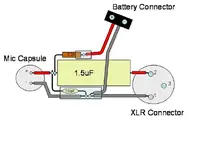Well I just came off a self-imposed vacation from posting because every time I posted something I thought was factual it seemed to start a fight. So I will have to accept that am I apparently a jerk.
So it ain't you, it's me.
Now, as for your questions: the answer to every one is it depends. Seriously, every circuit is a compromise. I know probably 15 different circuits you could use with WM61A and all those similar capsules. If one of them was perfect for everything, I would just know that one. At the moment, I happen to be building six different circuits.
OK, capacitors: yes, film caps are better than electros. They have measurably lower distortion. Yes, film caps are much bigger than electros. If you can find a size of film cap that's in the audio path and it's the value you need, you use the film cap. If you can't, you use the electro.
What value do you need? Well, a general design is going to incorporate a worst-case scenario. 10uF has a corner frequency of 16Hz into 1K ohm. Even that is not truly ideal for 20Hz response, but most mics don't have the flat bass response of a small omnidirectional capsule, so nobody complains. Ideally, you'd use something more like 33uF.
Now, if you are DIY, you can only consider your situation. Are you using a portable recorder with say 3K ohm input impedance? If so, you can get by with 3.3uF cap, and maybe your 1.5uF cap wouldn't even make you sad.
But wait, maybe you want a bass rolloff? Then use the smaller cap. It's kind of considered bad form to build a bass rolloff that is dependent upon another piece of gear's input impedance, but again if you are DIY, you can take that into account.
Let's say you are recording voice and acoustic guitar. Most male voices are baritones that bottom out around 80Hz. Guitars do too. So a bass rolloff could actually be a good thing, because it will filter out the rumble from your A/C unit, road noise, what have you. The majority of cardioid mics have a bass rolloff (if you are outside of their proximity zone), so in comparison, your omni mic with the bass rolloff might sound totally normal. And if you are taping a show where they are pumping the subs, a bass rolloff is a very good thing.
On the minus side, if you take that same mic on an instrument like grand piano or an orchestra, or pipe organ, it might sound a bit thin.
On drum overheads, I don't know. Some people like the full range sound of the kit in overheads, some do not. You decide.
OK, distortion. As you have noted, it's OK on quiet sources, but will degrade rapidly as SPL increases. It would be nearly useless for drum overheads, since I believe it hits 1% THD at around 98dBSPL.
To reduce distortion, you must limit the load on the capsule. My 4k7 resistor solution is only partial, because the input impedance of the preamp will be a parallel load on the FET. That circuit is good for 1% THD at about 110dBSPL.
You can get a further improvement by connecting only pin 3 to the capsule drain, and do an impedance-balanced arrangement for pin 2. That will result in reduced sensitivity. It's an approach for very loud sources where the circuit needs to be kept simple.
But if you want true high-SPL performance, you need a buffer circuit as in the MSH Kit mic. That is only one possibility; there are many different ways to do a buffer circuit. That will also get you low output impedance, so you can drive long cables.
Where are we? Pin 3. I wouldn't ground that directly. If there is a phantom power supply that's switched on, it would waste power and possibly drop the phantom voltage to other mic inputs. A lot of preamps, especially portable/USB/etc. ones, can't hack a load like that. Instead, connect a capacitor from pin 3 to pin 1. Better, use a series resistor and cap to create an impedance-balanced output.
WM61A is a fine capsule. Any of the circuits on this page can be built point-to-point in an XLR (well, not with film caps), maybe with a little practice.
So enjoy!

Oh, one more thing: a 9V? A single 9V can literally power about 200 of such mics without breaking a sweat. How about an A23, for smaller size?


